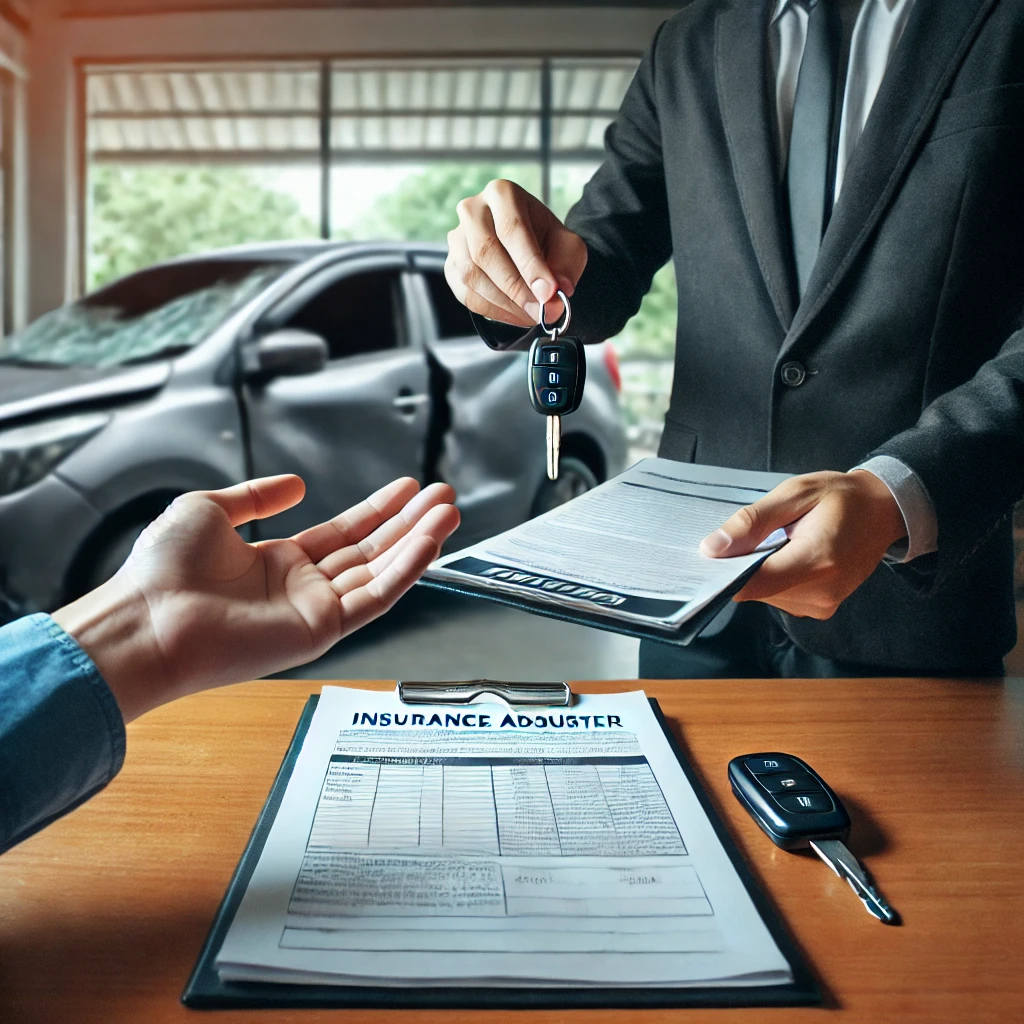Should I Release My Car to the Insurance Company? A Detailed Guide
After the shock of a car accident, the claims process begins. Amidst the phone calls and paperwork, you’ll hear a phrase from the insurance adjuster that can be confusing and even alarming: “We need you to release the vehicle to us.” What does this mean? Are you giving up your rights? What if you disagree with their assessment? This is a critical moment in your insurance claim, and the decision you make has significant financial consequences.
The short answer is: Yes, you must release your car to the insurance company *for inspection* to proceed with your claim. However, this is very different from releasing ownership by signing over the title.
You should NEVER sign over your vehicle’s title until you have formally accepted a written settlement offer for a total loss and have a clear understanding of when and how you will be paid.
This guide will walk you through every step of this process. We’ll clarify the two types of “release,” explain how an insurer declares a car a total loss, and empower you to negotiate a fair settlement, ensuring you don’t make a costly mistake during a stressful time.

Understanding the Two Meanings of “Releasing Your Car”
The core of the confusion lies in the word “release.” In an auto claim, it has two distinct meanings and stages. It is crucial to understand which one the adjuster is talking about.
Stage 1: Release for Inspection and Damage Assessment
This is the initial step and is a standard, non-negotiable part of the claims process. Releasing your car at this stage simply means you are giving the insurance company permission to:
- Tow your vehicle from the accident scene or your home to a designated location. This is usually a salvage yard or a partner auto body shop (like a Service King or Caliber Collision).
- Perform a thorough inspection of the damage. An appraiser needs to physically examine the vehicle, often taking it apart to some degree, to get an accurate estimate of the repair costs.
- Store the vehicle securely while the claim is being processed to prevent further damage or vandalism.
At this stage, you still own the car. You are not giving up any rights of ownership. Refusing to release the car for inspection will halt your claim entirely, as the insurer has no way to validate the damage and calculate what they owe you.
Stage 2: Release of Ownership (Signing Over the Title)
This stage only happens if your car is declared a “total loss.” This means the insurance company has determined that the cost to repair the vehicle is more than its value. In this scenario, the insurer offers to pay you the car’s value, and in exchange, you “release” the car to them permanently by signing over the title. The insurance company then owns the wrecked vehicle and will typically sell it for scrap or at a salvage auction to recoup some of their cost.
CRITICAL WARNING
The most important takeaway of this entire guide is this: Do not mix up these two stages. Give verbal or written consent to have your car towed and inspected. But do NOT sign any documents that transfer ownership, like the vehicle title or a power of attorney, until you are 100% satisfied with the total loss settlement offer.
The Total Loss Process: From Wreck to Check
If the damage is severe, the adjuster will begin the total loss evaluation. Understanding this process is key to ensuring you receive a fair settlement.
How is a Car Declared a Total Loss?
An insurer will “total” a vehicle when the estimated cost of repairs plus its potential scrap value exceeds its Actual Cash Value (ACV). The ACV is the market value of your car the moment *before* the accident occurred. Each state has a specific “total loss threshold.” In some states, it’s 75%, meaning if repairs cost 75% or more of the ACV, it must be declared a total loss. In others, the insurer has more discretion.
How is Actual Cash Value (ACV) Calculated?
This is the most common point of dispute in a claim. The ACV is not what you paid for the car, nor is it the Kelley Blue Book private party value. Insurers use third-party companies (like CCC ONE or Mitchell) to generate a market valuation report. This report analyzes recent sales of comparable vehicles (same make, model, year, trim) in your local area. The ACV is then adjusted for:
- Mileage: Higher mileage reduces value, lower mileage increases it.
- Condition: Pre-existing scratches, dents, or interior wear will lower the value.
- Recent Upgrades: New tires, a new stereo, or other recent improvements can increase the value, but you *must* have receipts to prove them.
What to Do If You Disagree with the ACV
The first offer is just that—an offer. You do not have to accept it. If the ACV seems low, you have the right to negotiate. Your steps should be:
- Request the Full Valuation Report: The insurer must provide you with the detailed report they used. Review it carefully. Check that the listed options, trim level, and condition are accurate.
- Do Your Own Research: Use online car sales sites (like Autotrader, Cars.com) to find comparable vehicles for sale *in your area*. Save screenshots of listings that support a higher value.
- Present Your Evidence: Send your findings to the adjuster in a polite, organized email. Include links to the comparable vehicles and receipts for any recent upgrades.
- Invoke the Appraisal Clause: If you still can’t agree, most policies have an “Appraisal Clause.” This allows you and the insurer to each hire an independent appraiser. The two appraisers then agree on a value or hire a third “umpire” to make the final decision.

The Alternative: Keeping Your Totaled Car (Owner-Retained Salvage)
In most states, you have the option to keep your totaled vehicle. This is called “owner retention.” If you choose this, the insurance company will pay you the ACV *minus* the salvage value of the car (the amount they would have gotten for it at auction). This may seem appealing, but it comes with significant drawbacks.
| Pros of Keeping Your Car | Cons of Keeping Your Car |
|---|---|
|
|
Starting Over: Insurance for Your Next Vehicle
Once your claim is settled, you’ll be in the market for a new car and, consequently, a new insurance policy (or an update to your existing one). This is the perfect opportunity to ensure you aren’t overpaying.
Don’t just automatically insure your new car with your old company. The accident may affect your rates, and another provider might offer a much better deal for your new circumstances. It is essential to get fresh auto insurance quotes online to see a full range of options. By comparing multiple companies, you can find the best car insurance rates and might discover that some of the cheapest car insurance providers offer excellent coverage you weren’t aware of.
Tools for Managing the Aftermath and Moving Forward
The claim process involves a mountain of paperwork and can leave you needing to equip a new (or new-to-you) vehicle. Here are a few products to make the transition smoother.

Durable Document Organizer
From the police report to the settlement offer and the title, an insurance claim generates a lot of paper. Keep everything in one safe, organized place with a fireproof and water-resistant document bag. It’s peace of mind during a chaotic time.
Check Price on Amazon
NOCO Boost Plus Jump Starter
After an accident, reliability in your next vehicle is paramount. A compact, powerful jump starter like the NOCO Boost ensures you’re never stranded by a dead battery. It also doubles as a power bank to charge your devices in an emergency.
Check Price on Amazon
Bluetooth FM Transmitter
If your next car is a more basic or older model, you don’t have to give up modern conveniences. This simple device plugs into your car’s power outlet and lets you stream music and make hands-free calls from your phone through your car’s speakers.
Check Price on AmazonFrequently Asked Questions (FAQ)
How long does the insurance company have to inspect my car?
Timelines vary by state law and the specifics of your claim, but generally, an insurer should inspect a vehicle within a few business days after you release it to them. Delays can happen, but they should communicate the reason to you.
Do I have to use the body shop the insurance company recommends?
No. You have the legal right to have your car repaired at any licensed shop of your choosing. However, your insurer may only guarantee the work of their “preferred” or “network” shops.
What happens if I still owe money on my totaled car?
The insurance company will send the settlement check directly to your lienholder (the bank or finance company) first. If the settlement (ACV) is more than your loan balance, the lienholder will sign the check, take their portion, and forward the remainder to you. If you owe more than the ACV, you are responsible for paying the difference, unless you have Gap Insurance.
Should I remove my personal belongings from the car before releasing it?
YES! Absolutely. As soon as it is safe to do so, remove everything of value from your car: phone chargers, sunglasses, documents from the glove box, items in the trunk, and especially your license plates (check your state’s DMV rules on this). The salvage yard is not responsible for your personal items.
Conclusion: You Are in Control of Your Claim
The request to “release your car” is a standard part of the insurance process, but it’s vital to know exactly what you’re agreeing to. Always allow the release for inspection to get your claim moving. But when it comes to the final release of ownership for a total loss, take a deep breath. Do your homework, review the valuation report, negotiate professionally, and never, ever sign over your title until the settlement is finalized and you are satisfied. An accident is disempowering, but by understanding the process, you can take back control and ensure you are treated fairly.